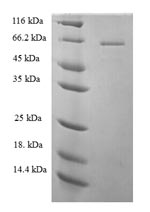The region for expressing recombinant Human PLCZ1 contains amino acids 1-415. This PLCZ1 protein is expected to have a theoretical molecular weight of 64.5 kDa. This PLCZ1 protein is produced using e.coli expression system. Fusion of the N-terminal 6xHis-SUMO tag into the PLCZ1 encoding gene fragment was conducted, allowing for easier detection and purification of the PLCZ1 protein in subsequent stages.
Human 1-Phosphatidylinositol 4,5-Bisphosphate Phosphodiesterase Zeta-1 (PLCZ1) is a key enzyme involved in sperm function. Its primary function is to hydrolyze phosphatidylinositol 4,5-bisphosphate (PIP2) to generate inositol trisphosphate (IP3), initiating calcium release during sperm-egg fusion. In reproductive research, PLCZ1 is pivotal for understanding fertilization mechanisms, and its dysfunction may contribute to male infertility. Additionally, PLCZ1's role in intracellular signaling implicates it in broader cell biology and signal transduction studies. Investigating PLCZ1 provides insights into reproductive processes, male infertility, and signaling cascades, offering potential applications in assisted reproductive technologies and advancing the understanding of cellular mechanisms related to fertility and intracellular communication.






